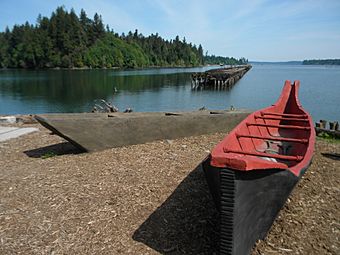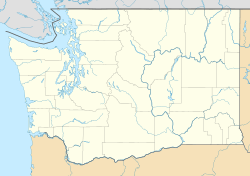Woodard Bay Natural Resources Conservation Area facts for kids
Quick facts for kids |
|
|
Weyerhaeuser South Bay Log Dump Rural Historic Landscape
|
|
 |
|
| Nearest city | Olympia, Washington |
|---|---|
| Built | 1928 |
| NRHP reference No. | 91001441 |
| Added to NRHP | October 2, 1991 |
The Woodard Bay Natural Resources Conservation Area is a special natural place near Olympia, Washington. It is protected as a natural reserve. This area was once a very busy place for the logging industry. It was known as the Weyerhaeuser South Bay Log Dump Rural Historic Landscape. Today, Woodard Bay is a safe home for many animals. You can find different kinds of birds, harbor seals, river otters, and bald eagles here. There is also a large group of bats. It is an important nesting site for great blue herons too. A special conservation project here, involving the State of Washington and The Nature Conservancy, was the first of its kind in the country.
Contents
What is the History of Woodard Bay?
Early Uses of the Land
People have used the Woodard Bay area for over 5,000 years. American Indian communities lived here when the coastline became stable. Later, in the 1850s, European settlers arrived. This was the start of the logging era around Puget Sound. The bay was named after Harvey and Solome Woodard, who were early pioneers in 1853.
Logging Operations at Woodard Bay
In the 1920s, the Weyerhaeuser Timber Company bought the site. They brought huge amounts of timber here by train every year. This timber came from Thurston and Lewis counties. The company used the site until 1984. A old logging railroad track crosses Woodard Bay on a wooden bridge. It also runs onto a pier in Henderson Inlet. Here, logs were dropped into the water. Workers would then gather them into large rafts. These rafts were floated to sawmills in Everett, Washington.
What Makes Woodard Bay Special?
The Woodard Bay area covers about 600 acres (2.4 square kilometers). It has a growing second-growth forest along five miles (8 kilometers) of shoreline. This includes Woodard and Chapman bays, which are part of Henderson Inlet. These shallow, saltwater bays are mostly untouched by development. This makes them perfect for wildlife. Many animals not usually seen near cities live here.
Amazing Wildlife at the Bay
A large group of bats lives under an old railroad pier. This pier is closed to visitors to protect the bats. Experts believe that in the past, similar numbers of bats lived in the area. However, they were spread out in many places. Now, they all gather in this one spot.
Harbor seals often rest on old log booms outside Chapman Bay. You can also see pigeon guillemots, cormorants, and a purple martin colony. These birds use the area for roosting and nesting.
Protecting the Animals
Chapman Bay is closed to boats. This helps protect nesting eagles and a heron rookery. The heron rookery moved to Woodard Bay in 2004. Woodard Bay itself is closed from Labor Day until April 1. This closure helps protect the waterfowl that spend the winter there.
Conservation Efforts
The Washington Department of Natural Resources started its natural conservation area program in 1987. The goal is to protect homes for fish and wildlife. It also provides places for quiet outdoor activities, research, and learning. Woodard Bay was one of the first four conservation areas in the state.
A new type of ocean conservation project began at Woodard Bay. The Nature Conservancy signed a 10-year agreement with the Washington Department of Natural Resources. They are working to bring back the Olympia oyster in 10 acres (40,000 square meters) of underwater land in Henderson Inlet. These oysters were once very common. This agreement is the first of its kind in the entire country. In 2008, the Conservation Area grew by another 90 acres (0.36 square kilometers).
What Facilities Are Available?
Woodard Bay has several facilities for visitors. There are meeting areas for small school groups. You can also find picnic tables, benches, and a toilet. An old camp car, once used as a cookhouse, has been restored. It now shows how it was used in the past. Much of this work was done by the Washington Conservation Corps and prisoners from the Cedar Creek Correctional Center.
The site is close to the northern end of the Chehalis Western Trail. There is a covered bike rack for cyclists to park their bikes. Please remember that bicycle riding is not allowed inside the Woodard Bay Natural Resources Conservation Area.
Images for kids




